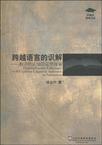跨越语言的识解
2009-8
上海外语教育出版社
谭业升
222
无
该书是以认知语言学为视角对翻译现象进行的一项系统研究。 从2000年起我就对翻译的认知语言学研究产生了兴趣,并撰写了《从语义认知的角度看翻译技巧》一文,投给了一家学术期刊,很快就收到了该杂志的录用通知。记得在当时的国内学界,翻译的文化、文学研究逐渐式强,而翻译的语言学研究经过十余年的风光逐渐式微。该学术刊物的肯定和鼓励给了我这个从攻读硕士学位起就一直专注于语言学和翻译学结合研究的学子很大的鼓舞。 其时,认知语言学研究正逐渐在国内外语学界兴起。2001年,《外国语》编辑部发起并主办了第一届全国认知语言学研讨会(至今已经举办了五届),一批年轻学者也正致力于介绍认知语言学的相关著述,并积极推动认知语言学研究在中国的发展。据我了解,复旦大学的博士生是当时最积极活跃的群体之一。同年,我非常幸运地考取了复旦大学,并师从熊学亮先生攻读博士学位。
为展示学术研究的最新动态和成果,并为广大优秀的博士人才提供广阔的学术交流的平台,上海外语教育出版社隆重推出“外教社博学文库”。该文库遴选国内的优秀博士论文,遵循严格的“专家推荐、匿名评审、好中选优”的筛选流程,内容涵盖语言学、文学、翻译和教学法研究等各个领域。该文库为开放系列,理论创新性强、材料科学翔实、论述周密严谨、文字简洁流畅,其问世必将为国内外广大读者在相关的外语学习和研究领域提供又一宝贵的学术资源。 本书是以认知语言学为视角对翻译现象进行的一项系统研究。它吸收了关联翻译论和翻译图示研究的成果,结合认知语言学的基本理论假设,创建了翻译中意义建构的认知模式。本书以“识解”作为文本对比分析的中介概念,刻画了具体翻译中涉及的多样化认知运作,并对若干翻译案例在系统描述的基础上结合三个认知原则进行了解释,模拟了翻译认知文本分析的框架。 本书内容丰富,例证翔实,对从事翻译教学和研究的教师、研究人员以及相关专业研究生都具有参考价值。
Chapter 1 Introduction and OverviewChapter 2 Toward a Cognitive Model of Meaning Construction in Translation 2.1 Introduction 2.2 Two Cognitive Constructivist Approaches to Translation 2.2.1 The Relevance theory of translation 2.2.2 A Schema-theoretic view of translation 2.2.3 Correlation between the Relevance theory of translation and the Schema-theoretic view of translation 2.2.4 An explanatory frame: Three cognitive principles governing translation in a sequence of priority 2.3 A Cognitive Linguistic View of Meaning Construction and Translation 2.3.1 What is cognitive linguistics? 2.3.2 The interaction between language and cognition in meaning construction in translation 2.3.3 Language schemata redefined and the sanctioning effects of linguistic conventions in translation 2.3.4 On-line construal in language use and translation 2.4 A Cognitive Model of Meaning Construction in TranslationChapter 3 Domain Conceptualization and Ground Construal in Translation 3.1 Domain Conceptualization and Ground Construal 3.1.1 Cognitive domains 3.1.2 Ground 3.2 Construal and Cognitive Abilities 3.3 Image Transformation/Construal Shifis in Meaning Construction and the Implications for Translation 3.4 The Methodology of Investigating Translational Shifts and Variations 3.4.1 Descriptive Translation Studies vs.Prescriptive Translation Studies 3.4.2 Comparative analytical method of the DTS 3.5 Translational Shifts and Variations along Different Dimensions of Construal 3.5.1 Base/profile organization 3.5.2 Level of specificity (abstraction) 3.5.3 Subjectivity vs.objectivity 3.5.4 Perspective 3.5.5 Prominence: figure/ground organization 3.5.6 Interaction between different construal operations 3.6 SummaryChapter 4 Image Schematic, Metonymic and Metaphorical Construal in Translation 4.1 Image Schema and Image Schematic Transformations in Translation 4.2 Metonymic Construal in Translation 4.2.1 A traditional view ofmetonymy and metonymy translation 4.2.2 Metonymy in cognitive linguistics and in translation ……Chapter 5 Language Schemata,Preferred Construal Patterns,and Cognitive Changes in TranslationChapter 6 Cognitive Styles of TranslationChapter 7 ConclusionBibliographyAppendix:A glossary in English and Chinese
Throughout the SLT, i.e. the Chinese poem, there are only 7 uses ofperson deixis, which indicate the participants of the speech event and theirrelations. In Tang Dynasty of China, qie妾, literally meaning concubine, is theaddressing term the wife uses to address herself, and lang郎 and jun君 (mylord) are terms used to address her husband. The addressing terms indicatethe power relation between wife and husband, in which the wife is inferior tothe husband. And with only 2 uses of the person deixis 妾, the wife describes13 events, and in most cases, "she" remains off-stage. All indicate that she isspeaking in a pretty reserved manner, though filled with deep love for herhusband in her heart. Unlike the original poem, the TLT objectifies the participants of eachevent the woman describes. There are 31 uses of person deixis in the TLT.And there are 18 uses of first person deixis. In some cases, the increased usageof person deixds may be dictated by the TL convention, but a large proportionof the increased uses are due to intentional objectification, to the effect thatthe two interlocutors are put vividly on stage. The translator employs directaddress "I" and "you" throughout the poem.
搭建学术交流平台,传播最新研究成果,学术理论新颖,研究领域广宽,材料客观翔实,论述周密严谨,文字简洁流畅。

无